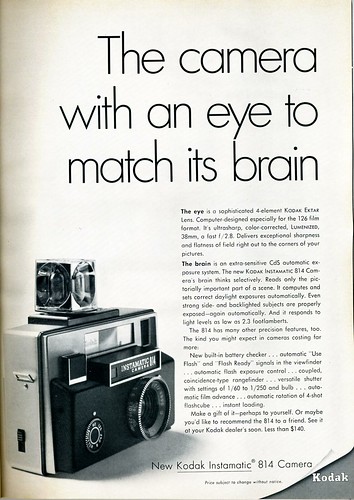Difference between revisions of "Kodak Instamatic 814"
Hanskerensky (talk | contribs) m (Now Category: I|Instamatic 814 Kodak) |
Hanskerensky (talk | contribs) (Added link to user manual page) |
||
| Line 37: | Line 37: | ||
==Links== | ==Links== | ||
| + | *[https://manualzz.com/doc/53746899/kodak-instamatic-814-instructions Kodak Instamatic 814 user manual] at [https://manualzz.com/ manualzz.com] | ||
*[http://kodak.3106.net/index.php?p=207&cam=1212 Kodak Classics: Kodak Instamatic 814] | *[http://kodak.3106.net/index.php?p=207&cam=1212 Kodak Classics: Kodak Instamatic 814] | ||
*[http://quirkyguywithacamera.blogspot.com/2017/10/inst-amour-kodak-instamatic-700-800.html Instamatic 700-800 Series] profiled at Adam Paul's [http://quirkyguywithacamera.blogspot.com/ Quirky Guy with a Camera] | *[http://quirkyguywithacamera.blogspot.com/2017/10/inst-amour-kodak-instamatic-700-800.html Instamatic 700-800 Series] profiled at Adam Paul's [http://quirkyguywithacamera.blogspot.com/ Quirky Guy with a Camera] | ||
Revision as of 06:39, 30 May 2022

|
| Kodak Instamatic 814 image by Thadeus Maximus (Image rights) |
The Kodak Instamatic 814 is a coupled coincident rangefinder camera for 126 (Kodapak) film cartridges - one of a large range of Instamatics. It was made by Kodak in the US, between March 1968 and August 1970. A surprisingly heavy camera, it is well constructed and has a superb 4 element Ektar 38mm f/2.8 lens. A Tessar design, the lens contains thorium oxide and is, in fact, radioactive (one of many Kodak lenses from the 40's, 50's, and 60's that share this attribute). The shutter has user-selected speeds of 1/60, 1/125, and 1/250 sec. plus bulb. Film advance is via a spring motor drive that is wound by pulling on a long nylon strap that rewinds into the camera's bottom.
Besides the redesigned Ektar lens, this model's main update from the otherwise-similar Instamatic 804 is substituting a CDS cell for the older selenium meter. This is powered by two PX825 mercury cells, and controls the camera's automatic aperture. Additionally the 814 omits the +/- exposure compensation wheel found on the 804. Period advertising[1] suggests this was possible as the CdS cell only read from the central subject area of the frame, and so was less likely to be thrown off by contrasting background brightness.
Specifications
- Camera Type: Rangerfinder
- Manufacture dates: 1968-1970
- Lens: Ektar f/2.8 38mm
- Shutter: 1/60 - 1/250, B (bulb)

|
| Ad, Feb 1969, Modern Photography scanned by Nesster (Image rights) |
- Exposure: Automatic
- Meter: CdS photocell
- Film type: 126 Cartridge
- Image size: 28 x 28 mm
- Meter battery: PX825 Mercury cell (2)
- Flash battery: type N (2)
- List price: $139 [1]
Notes
Links
- Kodak Instamatic 814 user manual at manualzz.com
- Kodak Classics: Kodak Instamatic 814
- Instamatic 700-800 Series profiled at Adam Paul's Quirky Guy with a Camera
- Instamatic 814 on www.collection-appareils.fr by Sylvain Halgand (in French)